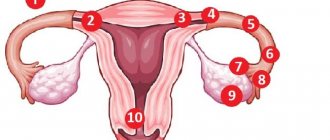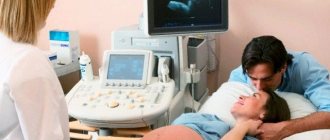Caesarean section is a common method of delivery. Surgical intervention is performed solely according to indications, since the natural course of childbirth is preferable for mother and child. Many representatives are interested in when menstruation is expected after cesarean section. Recovery usually depends on the type of feeding the infant receives.
The effect of cesarean section on the menstrual cycle
After a cesarean section delivery, it may take longer for your period to return. The recovery process is influenced by factors:
- Age. Representatives under 30-35 years old begin their periods earlier.
- The nature of pregnancy progression. The rapid resumption of menstruation occurs in the absence of complications.
- Lifestyle. Balanced nutrition, adherence to a regimen, and proper rest help restore the cycle.
The main factor on which the onset of menstruation depends is the presence of lactation. The first menstruation after a cesarean section occurs earlier in women who are not breastfeeding.
The nature of the discharge after the operation is completed
A woman needs to visit a gynecologist no later than one and a half months after giving birth. At this point, the lochia stops. The beginning of the first menstruation is also a reason for a visit to the gynecologist. The presence of deviations will help to diagnose postpartum complications in a timely manner. If a woman had problems with the regularity of her cycle before pregnancy, then after childbirth they disappear.
Norm
Upon completion of the cesarean section, spotting should not differ significantly from menstruation characteristic of the prenatal period. In the absence of pathologies, the color of the discharge varies from dark brown to scarlet. Painful sensations should be moderate. During the first 2-3 cycles, intense discharge . The optimal duration of menstruation is 6-8 days. Deviations of several days are not considered critical.
The first year after childbirth is accompanied by an irregular cycle . Delays are associated with unstable hormonal levels. To rule out pregnancy during this period, a woman should take a test every month. Anovulation in the first six months after childbirth is also normal.
Pathology
Atypical periods indicate the development of diseases of the reproductive system. Failure to comply with hygiene rules provokes infection into the uterine cavity. This leads to an inflammatory process. The result is the formation of adhesions , which bring discomfort and pain. Another cause of inflammation is congestion in the pelvic area. They occur due to insufficient contraction of the uterus.
Pathology is considered not only abundant, but also scanty discharge . A common cause of short periods is a tilted uterus . It occurs as a result of an inflammatory process. The danger of the pathology is a decrease in the ability to conceive. In case of deviations in the functioning of the reproductive system, menstruation differs in the following signs:
- brown or dark red spotting
- heavy bleeding , in which the pad has to be changed more than five times a day;
- pungent and unpleasant odor from the genitals;
- irregular nature of critical days;
- the presence of purulent discharge ;
- excessive presence of mucous secretion ;
- itching of the genitals.
When to expect menstruation after cesarean section
The type of food a baby eats determines the speed of recovery of critical days. However, their absence after a CS for a year is normal.
When breastfeeding
Pediatricians and gynecologists believe that the optimal minimum period of exclusive breastfeeding is 6 months. During breastfeeding, prolactin is actively synthesized on demand. This hormone helps produce the required amount of milk and block ovulation. Pregnancy with full breastfeeding during the first 6 months is practically excluded.
Menstruation after a cesarean section with fairly frequent breastfeeding may be absent during the entire period of lactation, which is not considered a pathology. Most women start menstruating within a year. The recovery of the cycle is influenced by the individual characteristics of the woman and the frequency of breastfeeding.
With artificial feeding
If there is no breastfeeding, the cycle can be restored a month after the cessation of lochia. Simultaneously with the menstrual cycle, the ability to conceive is restored, which should be taken into account when choosing a contraceptive.
Menstruation after a CS with artificial feeding may begin later due to tissue regeneration. If there are no critical days for a long time, it is advisable to perform a rapid test to determine a possible pregnancy.
Effect of feeding
An important factor influencing when menstruation comes after a cesarean section is lactation. The active work of the hormone prolactin contributes to the appearance of milk in a woman. Then the hormone begins to influence the activity of the ovaries, which causes them to become somewhat lethargic.
Menstruation after cesarean section with breastfeeding occurs later; as a rule, the onset of menstruation should be expected after 4-6 months. By this time, lochia, which serves as a harbinger of menstruation in women after childbirth, will no longer be released.
Over time, prolactin production will gradually decrease, which usually coincides with the transition of the baby to complementary foods. While prolactin is working at full capacity, the menstrual cycle will not begin.
Unlike the work of prolactin during breastfeeding, during artificial feeding of the baby, the level of the hormone in the mother’s body decreases faster, so after two to three months menstruation begins after a cesarean section.
Menstruation after CS
The nature of the first menstruation indicates possible disorders and pathologies that were provoked by surgical intervention. Infections and poor healing of sutures are common.
What can be the first period after cesarean?
Usually menstruation after a CS is quite intense. Heavy first periods after cesarean section are caused by hormonal changes and cycle restoration processes. This phenomenon is considered normal in the absence of deterioration in health.
Important! In general, the characteristics of the first menstruation depend on the characteristics of the woman’s body and hormonal levels.
How long do menstruation last after cesarean section?
During the first cycle, ovulation may be absent, which is associated with inadequate recovery of the body. Over the course of several months, the cycle may be inconsistent. After a few months, the menstrual cycle should acquire stable characteristics.
After cesarean section, the length of the cycle should vary from 21 to 35 days. The duration of menstruation is 3-7 days. Changing these parameters down or up requires examination by a gynecologist.
Heavy menstruation after cesarean section
Very heavy periods after a cesarean section may indicate various reproductive disorders. The cause of intense discharge is sometimes endometrial hyperplasia.
Attention! Heavy periods with clots after cesarean section, accompanied by weakness and pale skin, require consultation with a doctor.
Possible deviations
A woman in labor needs to carefully monitor her cycle, as well as the duration, intensity and quality of menstruation. It is best to mark the day of the first regula on the calendar, and if there is no delay in menstruation, it means that the cycle is restored normally.
Let's look at the symptoms that should alert you, as they may indicate possible deviations:
- Excessive discharge, which causes abdominal pain after cesarean section. This may indicate the presence of placental polyps or uterine damage.
- Unusually scanty periods. As a rule, this indicates an exacerbation of chronic processes in the body. If the amount of blood loss does not differ significantly from what it was before pregnancy, then perhaps the reason is the formation of the cycle.
- There are no periods for a long time after a cesarean section, and the delay is replaced by sudden and severe bleeding. This phenomenon is a clear sign of fibroids or endometriosis. In addition, such a problem may indicate serious hormonal imbalances in the body, failure of ovarian function. As a rule, identical deviations are observed in patients with complicated pregnancies, when edema, increased blood pressure, convulsions, etc. occurred before birth.
- Prolonged regulation with clots. Clots often indicate existing diseases of the reproductive system.
- Menstruation does not begin at all, although lactation is absent. The reasons for this may be different - an examination of the uterus, ovaries, and also a check of hormone levels is required.
The first regulations after a CS are a “mirror” of the rehabilitation period. Therefore, it is very important to monitor its regularity and quality characteristics. Any changes should be considered carefully. After all, whether a woman will be able to become pregnant and give birth in the future depends on how quickly and correctly the cycle is restored.
Restoring the menstrual cycle after cesarean section
The intervention is performed under anesthesia. During a caesarean section, not only the abdominal wall is cut, but also the surface of the uterus from the front. Women's bodies spend enormous resources on the process of tissue regeneration. This affects general well-being, which is manifested by a possible delay in the first menstruation after a cesarean section.
Why no period after cesarean section?
After a caesarean section, the same physiological processes occur in the female body as are observed during normal childbirth. Return to their original indicators:
- size of the uterus;
- features of the ovaries;
- hormonal background.
Attention! Menstruation after a cesarean section may be absent for a year. This is often associated with breastfeeding.
After the CS, the body recovers. The size of the uterine body decreases due to contractions. The surface of the bleeding wound gradually heals. The healing process is accompanied by lochia. This is a postpartum reddish discharge observed for 6-8 weeks.
The nature of lochia changes throughout the recovery period. Initially, the discharge has a specific smell and is distinguished by clots. Then their number is reduced, and the color becomes darker. After a few weeks, the discharge becomes light.
Since tissue is damaged during surgery, lochia may persist for a longer period of time. The recovery process is affected by compliance with the following rules:
- Timely emptying of the bladder. An overfilled bladder contributes to bleeding and poor healing of the suture due to pressure on the uterus.
- Maintaining intimate hygiene. It is necessary to wash regularly. It is essential to use fragrance-free pads and replace them frequently.
- Attaching the baby on demand. Constant application stimulates uterine contractions.
Attention! Lochia is not menstruation. As they cease, the body returns to the physiological state that is observed in the absence of pregnancy.
Differences from childbirth
Despite surgical intervention, the female body otherwise remains in the same condition as after natural childbirth. Hormone levels begin to return to previous levels, the uterus shrinks, and the ovaries restore their function.
Therefore, the differences from natural childbirth lie only in the moment the child is born. During a healthy recovery from surgery, the lesions will heal but may bleed.
This discharge is called lochia, and is often mistaken for menstruation after a cesarean section. They also have a scarlet blood color and can begin in the first 1.5-2 months after birth. Then the discharge becomes darker and smaller in volume, and at the completion phase it becomes lighter and stops completely.
Possible complications
You should consult a doctor if you observe the following signs:
- Early cessation of lochia, which is sudden. This symptom may indicate a curvature of the uterus and the risk of developing endometritis.
- Scanty bleeding. The phenomenon is considered a sign of insufficient uterine contraction.
- Cycle instability six months after delivery. Normally, the cycle stabilizes within six months.
- Long-term bleeding. The suture on the uterine body prevents the organ from contracting. If during critical days you need more than 1 pad per hour, you should immediately consult a gynecologist. An increase in the duration of menstrual bleeding is also considered an alarming signal.
- Discharge accompanied by an unpleasant odor. An unpleasant odor during menstruation usually accompanies infectious processes.
- Prolonged spotting before and after menstruation. Spotting may be a sign of endometriosis.
- Frequent menstruation. Short cycles are considered normal only during the first 3 months after a cesarean section. Otherwise, there is a risk of disturbances in the contractile activity of the uterus. Frequent periods can be caused by the effects of certain medications.
Attention! A woman needs to monitor the nature of her periods in order to notice signs of pathology in time and contact a specialist.
Doctors' opinion
Obstetrician-gynecologist of the first category Artur Medyanikov advises: “First of all, I would like to once again draw the attention of women to the fact that after childbirth by Caesarean, menstruation returns within the same time frame as after a natural birth. If a young mother is breastfeeding, then you should not wait for menstruation earlier than six months later. When a baby grows up on artificial formulas, in most cases, the critical days for women in labor begin within a couple of months. But definitely everything depends on the individual characteristics of the body. There are many factors that influence the speed of the onset of menstruation.
The most important of them is age. Thus, the body of a young woman requires less time to fully recover than an old woman. We cannot discount genetic predisposition, lifestyle, etc. For example, due to malnutrition, smoking, alcohol abuse, chronic fatigue and stress, the first regulations can begin very early - even a month after a cesarean section.
The most important thing is that every woman after childbirth should take care of herself, especially with regard to menstruation, since menstruation is an indicator of the reproductive health of a young mother. Be sure to pay attention to the abundance of discharge - large volumes of blood should be released only on the first day. Then the regulation normally declines. The presence of pain should also alert you - the stomach hurts “these days” in most cases only in the presence of inflammation and diseases of the reproductive system. It is important to note the smell of the discharge - it should not be there. If a woman follows all the rules of hygiene, but the regula still smells unpleasant, she needs to consult her doctor.
Postpartum periods should not differ from “pre-pregnancy” ones in color. The presence of mucus and small clots is normal. But bright scarlet or, conversely, dark red blood should alert you.”
Doctors' recommendations
By following basic rules, you can influence the normalization of menstrual function:
- maintaining optimal sleep and wakefulness patterns;
- moderate physical activity and walks in the fresh air;
- balanced diet;
- refusal of intimate life for 2 months;
- performing hygiene procedures in the shower;
- frequent replacement of gaskets;
- protection from pregnancy for 3 years.
Attention! Menstruation after a cesarean section can begin within a month. What is essential is not the time of occurrence of critical days, but their parameters.
How long does the first period last?
Menstruation after a cesarean section, most often, for the first time can occur without the ripening of the egg, since the functions of the body have not yet been fully restored (more details in the article:). In this case, bleeding can be intense and lasts up to a week. Then all processes are normalized, the duration and intensity of menstruation return to the state it was before pregnancy. The activity of the ovaries is completely restored and the next pregnancy is possible.
A woman needs treatment if she has chronic disorders, infection or inflammation. During pregnancy, and then after childbirth, the body re-experiences the hormonal adjustment of all systems, including menstruation:
- stabilization of deadlines;
- reduction of pain;
- reducing the duration and severity of bleeding;
- reducing the effect of PMS.
Reviews about the resumption of menstruation after CS
Feedback from women indicates the individual nature of the critical days after surgical delivery.
Tatyana Viktorovna Belova, 33 years old, Tolyatti
My period started 2 and a half months after the CS. I almost didn’t breastfeed the baby. At first it was painful because of the stitch, and then there was not enough milk. The cycle was restored immediately. The next menstruation was exactly 4 weeks later.
Veronika Aleksandrovna Titovets, 29 years old, Khabarovsk
My first periods after cesarean were very heavy. But I attribute this not to the operation, but to long-term feeding. Critical days came unexpectedly, even my stomach did not hurt. After pregnancy and childbirth, PMS stopped bothering me.
The influence of gestation
Gestational history also influences when periods begin after a cesarean section. If a woman was not ill during pregnancy, there were no complications in the form of leaks, hypoxia, or chronic diseases of the mother’s body, the first menstruation after cesarean can be calculated based on the method of feeding.
If complications have occurred, recovery after a cesarean section may be delayed; accordingly, it is possible to calculate when the first period arrives only taking into account these complications and the mother’s health status.










